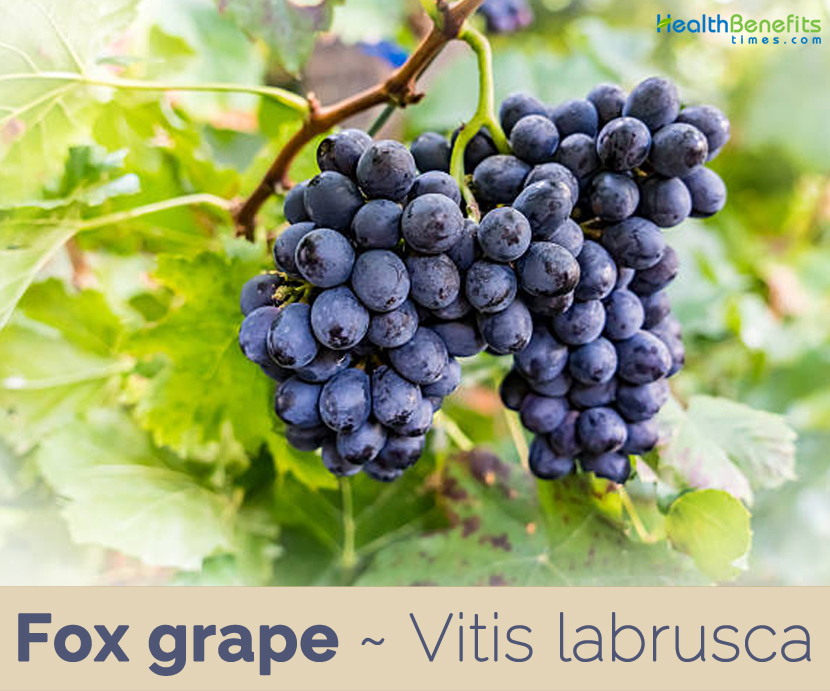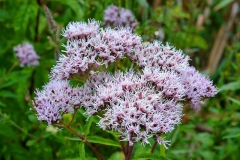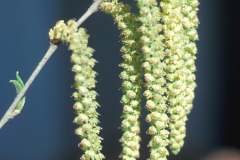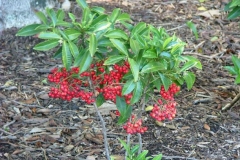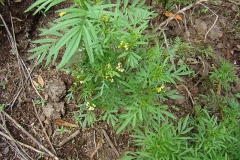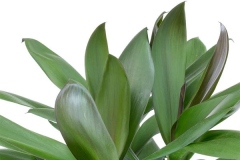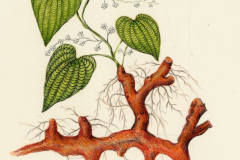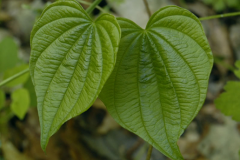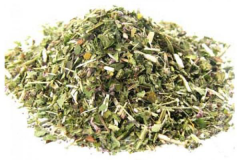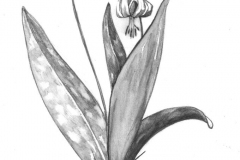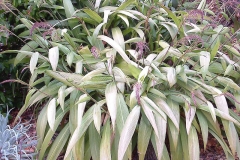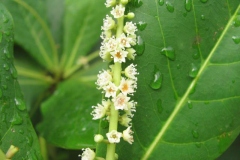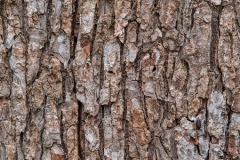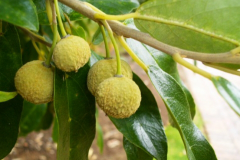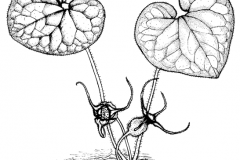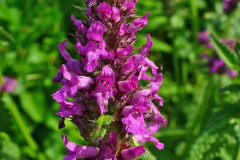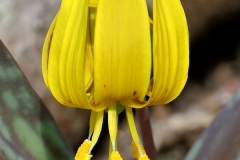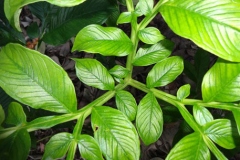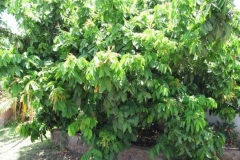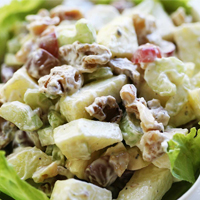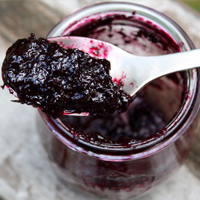Plant Description
Fox grape is a woody, deciduous vine that climbs up to 12m high. The plant is found growing in lowland to upland forests, esp. disturbed habitats, thickets, roadsides, fencerows, meadows or sandy hills, wet to mesic sandy thickets, borders of sandy woodlands, riverbanks, areas along railroads, and wet to moist sand prairies. The plant prefers a deep rich moist well-drained moderately fertile loam. It also grows best in a calcareous soil. Young shoots are light green and more or less covered with woolly brown hairs, but becoming less hairy with age. Trunk bark is brown and very shredded, while mature woody stems are light brown to reddish brown, smooth, and sometimes finely grooved.
Leaves
Widely spaced leaves are alternate along the shoots and stems. They are 4-8 inches long and a little less across. The leaves are oval-cordate in overall shape. They usually have 3 palmate lobes that are broad and shallow, while their margins are finely and shallowly dentate (denticulate). The upper leaf surface is dull green (or yellowish green in bright sunlight) and hairless, while the lower surface is brownish white from woolly hairs. On the lower leaf surface, there is a mat of appressed white-woolly hairs, over which there is a layer of longer brown-woolly hairs. The latter have a tendency to fade away with age. The texture of the leaves is somewhat leathery and their venation is palmate. The slender petioles are 4-6 inches long and more or less covered with woolly brown hairs that tend to fade away with age. Directly opposite from each leaf, there is either a forked tendril or flowers/fruit.
Flower
Flowers are about 1/8 inches (3 mm.) across and greenish yellow in appearance. These flowers can be unisexual (male or female) or perfect. Each flower has 5 deciduous petals, an insignificant calyx that has been reduced to a flat disk, and the reproductive organs. Each male or perfect flower has 5 prominent stamens, while each female or perfect flower has a superior ovary with a short style. The blooming period occurs during late spring or early summer and lasts about 1 week. The flowers have a sweet musty fragrance.
Fruit
Fertile female flowers are replaced by berries that are arranged in drooping panicles about 3-8 inches long. After they mature during the late summer or the fall, these berries are ½-¾ inches across and globoid to globoid-ovoid in shape. They are bluish black (rarely amber) and either with or without bloom on the outside, while on the inside they have juicy flesh and 2-6 seeds. The flavor of ripe berries varies from sweet-tart to sweet with musky overtones. Seeds are rounded with a short beak, 5-8 mm long and 4-6 mm broad.
Health benefits of Fox grape
Listed below are few of the health benefits of Fox grape
1. Decrease blood pressure
Fox grape contains many flavonoids, including resveratrol, which can help decrease blood pressure by improving the fluidity of the blood. Resveratrol also relaxes the arterial walls to allow sufficient circulation and decrease the pressure in the arteries.
2. Maintain healthy breast tissue
Fox grapes contain resveratrol, which protects the DNA in our cells against mutations that occur. Studies show that resveratrol is specifically beneficial in protecting breast tissue from the mutations that can take place in certain breast cancers.
3. Boost your immunity
Fox grapes have been shown to increase the production of the cells in our body that fight off disease and foreign invaders. Boosting these natural killer cells and T-cells will keep your immune system in tip-top shape during cold and flu season.
4. Eat grapes to stay sharp
Many degenerative diseases, including Alzheimer’s and dementia, begin with the accumulation of certain proteins and foreign bodies in the brain. Fox grapes have been shown to prevent the accumulation of these potentially harmful substances. This helps keep your brain sharp and your nervous system healthy.
5. Anti-inflammatory
Fox grapes contain a variety of polyphenols that can reduce the inflammatory response in the body. These grapes also have the antioxidant ability to wash up free radicals in the body and keep you looking younger, longer.
Traditional uses and benefits of Fox grape
- The leaves are hepatic.
- An infusion has been used in the treatment of diarrhea, hepatitis, stomach aches, fevers, headaches and thrush.
- Externally, the leaves are poultice and applied to sore breasts, rheumatic joints and headaches.
- Wilted leaves have been applied as a poultice to the breasts to draw away soreness after the birth of a child.
- An infusion of the bark has been used to treat urinary complaints.
- Leaves, roots, and bark are used to treat diarrhea, ‘bad blood’, liver problems, irregular urination, and breast soreness after childbirth.
- Poultices of leaves can be applied for topical pain relief or fever.
Ayurvedic health benefits of Fox grape
- Diarrhea: Make an infusion of Fox grape dried leaves. Take it twice a day.
- Rheumatoid Arthritis: Make a poultice of fox grape fresh leaves. Apply it on the painful joints.
- Urinary problems: Make an infusion of fox grape bark powder. Take it, twice a day.
Culinary Uses
- Fruit can be consumed raw or dried for winter use.
- The fruit can also be made into pies, preserves etc.
- Young leaves can be consumed after cooking.
- Pleasant acid flavor, they are cooked as greens or can be wrapped around other foods and then baked, when they impart a pleasant flavor.
- Young tendrils can be consumed raw or cooked.
- Sap should not be harvested in quantity or it will weaken the plant.
- Oil is obtained from the seed.
- Fruits are made into beverages, breads, and cakes, or simply eaten raw.
Other facts
- Yellow dye is obtained from the fresh or dried leaves.
- Plant is used as a root stock for the common grape, V. vinifera, especially in areas where phylloxera disease is prevalent.
- Decoction of roots can be mixed with horse feed as a veterinary aid.
Waldorf salad
Ingredients
- 2 cups red apples, diced
- 2 cups green apples, diced
- 4 stalks celery, diced
- 2 cups concord grapes, seedless
- 1 cup walnuts
- 4 tablespoons walnut oil
- 2 tablespoon apple cider vinegar
- 1/2 teaspoon salt
Directions
- Toss together the apples, celery, grapes, and walnuts in a large bowl; set aside.
- In a small bowl, whisk together the walnut oil, apple cider vinegar and salt.
- Toss together and serve.
Fox Grape wine
Ingredients
Direction
- Heat grapes in water (enough to almost cover) to just about boiling point.
- Pour into crock containing raisins and sugar.
- Add water; cover with cheesecloth and let stand in cool cellar about 3 weeks or until fermentation has ceased.
- Stir twice a week. Strain and bottle but do not seal for 3 days.
- Lay bottles on side.
Fox Grape Jelly
Ingredients
- Green or ripe fox-grapes
- 1 pint water
- Sifted sugar
Directions
- Fill a kettle with the grapes picked from their stems. Add water and boil them until the skins burst.
- Mash them and strain through a sieve.
- To every pint of juice, allow a pound of sifted sugar. Boil together for half an hour.
- Put the jelly in glasses. The next day, cover closely.
Fox Grape Jam Tart
Ingredients
- 2 egg yolks and 1 whole egg
- 120 g of sugar
- 120 g of butter
- Brandy
- 300 g of flour and a little bag of baking powder
- 1 jar of fox grape jam
Directions
- Make the short crust pastry by blending together all the ingredients.
- Use part of the dough to cover the base of a grease mould and spread the fox grape jam on top of the pastry.
- With the rest of the dough make a few little stripes, later you will use them to decorate the tart.
- Bake at 155 degrees for 15/20 minutes.
References:
https://www.itis.gov/servlet/SingleRpt/SingleRpt?search_topic=TSN&search_value=28608#null
https://davesgarden.com/guides/pf/go/58366/
https://npgsweb.ars-grin.gov/gringlobal/taxonomydetail.aspx?id=41879
https://pfaf.org/USER/Plant.aspx?LatinName=Vitis+labrusca
https://www.cabi.org/ISC/datasheet/56499
http://www.missouribotanicalgarden.org/PlantFinder/PlantFinderDetails.aspx?taxonid=299535
https://plants.usda.gov/core/profile?symbol=vila8
https://en.wikipedia.org/wiki/Vitis_labrusca
https://gobotany.newenglandwild.org/species/vitis/labrusca/
Comments
| Fox grape Quick Facts | |
|---|---|
| Name: | Fox grape |
| Scientific Name: | Vitis labrusca |
| Origin | Woodlands and forest margins in eastern North America from Nova Scotia to Ontario south to Louisiana and Florida |
| Colors | Green when young turning to dark red to black |
| Shapes | Berries are 2 cm in diameter and globoid to globoid-ovoid in shape. Fruits are sweetish which contain 6.6 - 16.6% sugars. |
| Taste | Sweet-tart to sweet with musky overtones |
| Health benefits | Maintain healthy breast tissue, Boost your immunity, Anti-inflammatory, Decrease blood pressure and stay sharp |
| Name | Fox grape |
|---|---|
| Scientific Name | Vitis labrusca |
| Native | Woodlands and forest margins in eastern North America from Nova Scotia to Ontario south to Louisiana and Florida |
| Common Names | Concorde grape, Fox grape, Grapevine rootstock, Skunk grape, Wild vines, Northern fox grape, American grape, slipskin grape, slip-skin grape, Bland’s grape, Isabella grape, Labruscan grape |
| Name in Other Languages | Albanian: hardhi Bulgarian: Diva amerikanska loza (дива американска лоза) Chinese: Mei zhou pu tao (美洲葡萄) Czech: Réva americká, réva liščí Danish: Amerikansk vin, Vildvin Dutch: Verwilderde wingerds English: Concorde grape, Fox grape, Grapevine rootstock, Skunk grape, Wild vines, Northern fox grape, American grape, slipskin grape, slip-skin grape, Bland’s grape, Isabella grape, Labruscan grape Finnish: Luonnonvarainen viiniköynnös French: Lambreuche, Lambrunche, Lambruche, Lambrunche sauvage, Lambrusque, Labrusca, Llambrusca, Vigne americaine, Vigne cotonneuse, Vigne isabelle, Vigne sauvage, Vigne lambruche, Vigne framboisier, raisin de renard, vigne des chats German : Fuchsrebe, Isabellarebe, Wildreben, Fuchsweinrebe, tessiner Rebe Greek: Agrioklima (Aγριόκλημα), Agriambelos (Aγριάμπελος) Hungarian: Vadszőlő Italian: Labrusche, Lambrusca, Lambrusche, uva fragola, vite americana Japanese: Amerika budou (アメリカブドウ), Raburusuka budou (ラブ ルスカブドウ) Portuguese: Isabela, Videiras bravas, labrusca, labrusca, videira-americana, videira-isabela, videira-morangueira Russian: Vinograd vida (Виноград вида) Spanish: Labrusca, Labruscas, Parra brava, Parrón, Vid Silvestre, Parrón, Swedish: Labruskavin Turkish: Kokulu üzüm Ukrainian: Vynohrad izabella (виноград ізабелла) |
| Plant Growth Habit | Woody, deciduous vine |
| Growing Climates | Lowland to upland forests, esp. disturbed habitats, thickets, roadsides, fencerows, and even meadows or sandy hills, wet to mesic sandy thickets, borders of sandy woodlands, riverbanks, areas along railroads, and wet to moist sand prairies |
| Soil | Prefers a deep rich moist well-drained moderately fertile loam. Grows best in a calcareous soil |
| Plant Size | Climbs up to 12m |
| Shoot | Young shoots are light green and more or less covered with woolly brown hairs, but becoming less hairy with age. |
| Bark | Trunk bark is brown and very shredded, while mature woody stems are light brown to reddish brown, smooth, and sometimes finely grooved. |
| Leaf | Oval-cordate in overall shape; they usually have 3 palmate lobes that are broad and shallow, while their margins are finely and shallowly dentate (denticulate). The upper leaf surface is dull green (or yellowish green in bright sunlight) and hairless, while the lower surface is brownish white from woolly hairs. On the lower leaf surface, there is a mat of appressed white-woolly hairs, over which there is a layer of longer brown-woolly hairs |
| Flowering season | May to July |
| Flower | Flowers can be unisexual (male or female) or perfect. Each flower has 5 deciduous petals, an insignificant calyx that has been reduced to a flat disk, and the reproductive organs |
| Fruit Shape & Size | Berries are 2cm in diameter and globoid to globoid-ovoid in shape. The fruits are sweetish which contain 6.6 – 16.6% sugars. |
| Fruit Color | Green when young turning to dark red to black |
| Seed | Rounded with a short beak, 5-8mm long and 4-6mm broad |
| Propagation | By seeds |
| Flavor/aroma | Distinctive musky aroma |
| Taste | Sweet-tart to sweet with musky overtones |
| Plant Parts Used | Leaves, fruits, oil |
| Season | September to October |
| Health Benefits |
|


